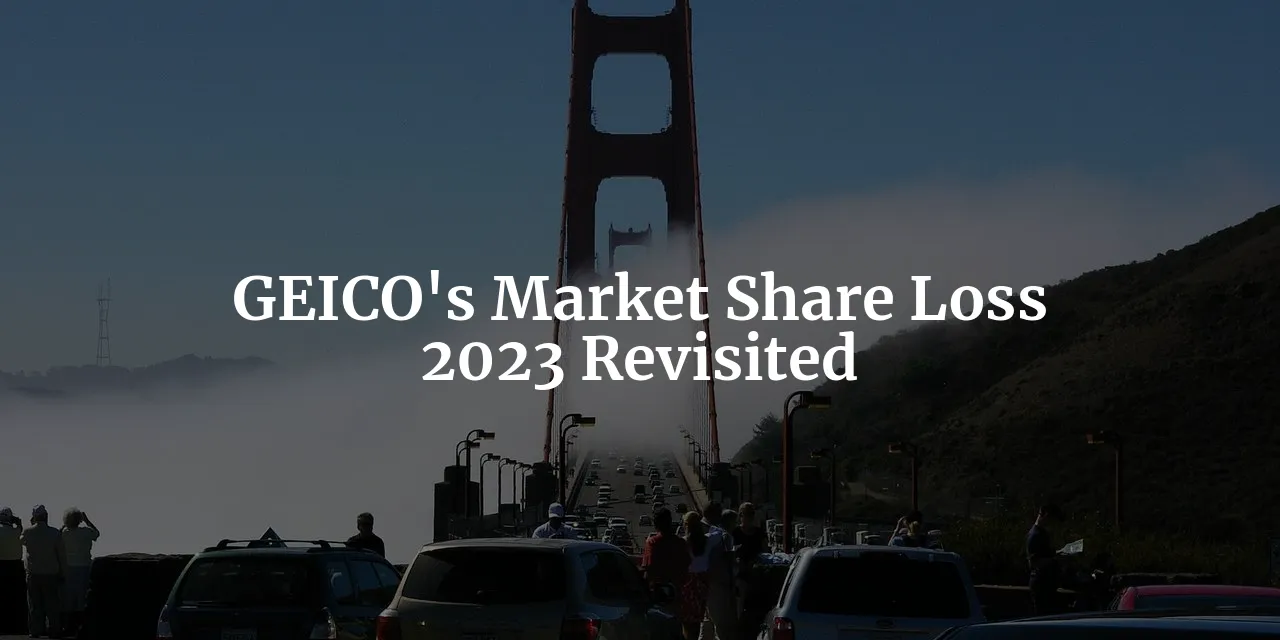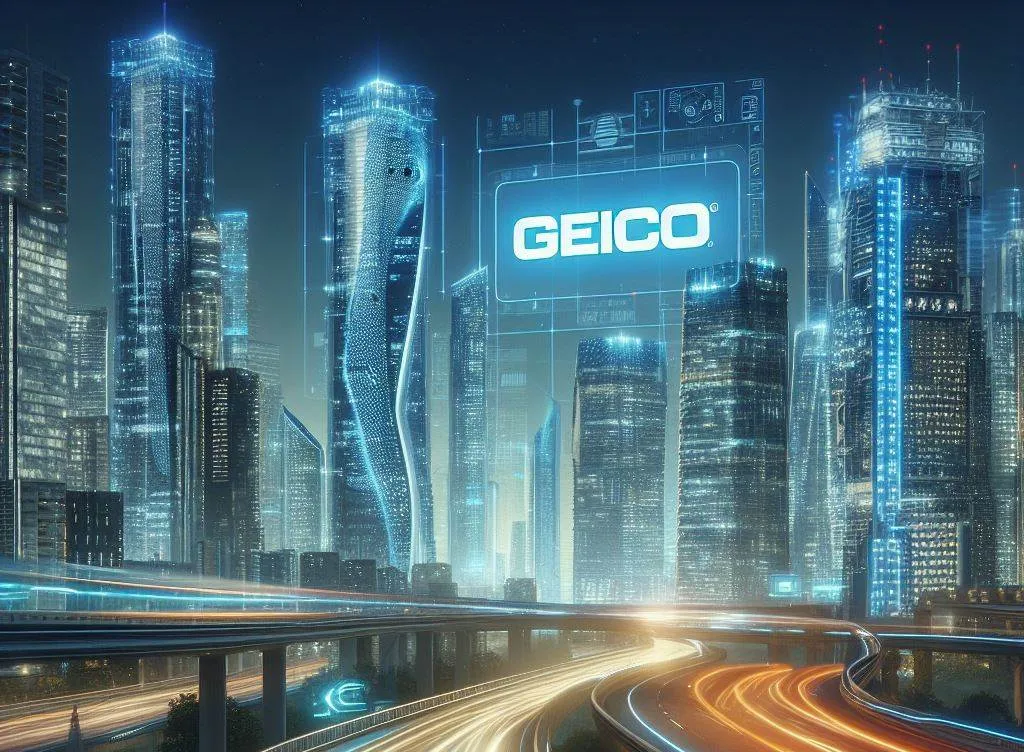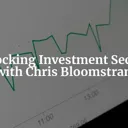Tags: GEICO
This fanpage is not officially affiliated with Berkshire Hathaway: Disclaimer
It is about time to talk about GEICO's market share loss and considerable layoffs in 2023. Let us explore strategic recalibrations, operational adjustments, and future prospects within Berkshire Hathaway's diverse portfolio.

Introduction
In the expansive portfolio of Berkshire Hathaway, GEICO has long stood as a beacon of profitability and market dominance within the auto insurance sector ↗. Historically, GEICO has not only been a significant contributor to Berkshire's bottom line but also a prime example of successful direct-to-consumer insurance sales. However, the year 2023 has unfolded a different narrative, one where GEICO's once unassailable market share has seen a notable decline. This trend raises a pivotal question for Berkshire Hathaway shareholders: Is the market share loss in 2023 a cause for concern, or is it a strategic recalibration in the face of evolving industry dynamics?
The auto insurance industry, marked by its competitiveness, requires giants like GEICO to continuously navigate through a maze of challenges, from changing consumer behaviors to technological advancements ↗↗. This article embarks on an analytical journey to dissect GEICO's market position, its performance in 2023, and the broader economic and industry-specific factors at play. By delving into the strategic decisions behind GEICO's operational adjustments and comparing its trajectory with that of its competitors, we aim to provide a comprehensive understanding of what these developments mean for Berkshire Hathaway's future in the auto insurance landscape.
As we set the stage for this exploration, it's crucial to underscore the importance of not just analyzing the present scenario but also understanding the historical context that has shaped GEICO's strategies over the years. From its emphasis on profitability over growth to its rapid strides in telematics, every aspect of GEICO's operation has been a calculated move. This article promises a thorough, interesting, and entertaining examination of GEICO's current challenges, strategic responses, and future prospects, all through the lens of its significance to Berkshire Hathaway shareholders.
GEICO's Market Position and 2023 Performance
The year 2023 has been a watershed for GEICO, marked by a significant reduction in staffing by 20%, which saw its head count fall from 38,285 in 2022 to 30,584. This drastic move was not without its repercussions, leading to a 1.4 percentage point decrease in market share, bringing it down to 12.4% from the previous year's 13.8% 1. This decline in market share is juxtaposed against the backdrop of Progressive's expansion, which has seen its market share increase by 1.6 percentage points to 15.3% in the same period. Such comparative dynamics underscore the competitive landscape of the auto insurance sector and signal a shift in the balance of power.
Despite the reduction in workforce and market share, GEICO's underwriting profit tells a story of financial recovery and strategic recalibration. From a loss of $1.9 billion in 2022, GEICO's underwriting profit surged to $3.6 billion in 2023 1. This remarkable turnaround is indicative of GEICO's willingness to shed policyholders, a move aimed at restoring profitability even if it means losing ground in terms of market coverage. This decision, while seemingly counterintuitive, reflects a deeper strategic emphasis on profitability over growth—a principle that has historically guided GEICO's operations within the Berkshire Hathaway portfolio.
The strategic decision to reduce staffing and focus on profitability has been complemented by GEICO's rapid strides in telematics. This technological advancement not only positions GEICO to better assess risk and tailor pricing but also to potentially regain its competitive edge in the market. The balance between market share and financial performance, thus, remains a key focal point for GEICO as it navigates the challenges and opportunities of 2023.
Reflecting on GEICO's historical performance, it's evident that the company has consistently prioritized operational efficiency and profitability. The current strategic adjustments, from workforce reduction to embracing telematics, are in line with GEICO's long-standing ethos. As the third-largest insurer in the U.S. auto insurance market, behind State Farm and now Progressive, GEICO's journey through 2023 is a testament to its resilience and adaptability in the face of industry shifts and competitive pressures 5.
Thus, GEICO's market position and performance in 2023 highlight a period of strategic recalibration aimed at reinforcing its financial health and operational efficiency. Despite the loss in market share, the company's significant underwriting profit and strategic investments in technology suggest a forward-looking approach that may well redefine its competitive standing in the years to come. For Berkshire Hathaway shareholders, understanding these dynamics is crucial in assessing GEICO's continued contribution to Berkshire's diversified portfolio and its future prospects in the ever-evolving auto insurance industry.

Competitive Landscape and Industry Trends
The U.S. auto insurance market is a fiercely competitive arena, dominated by major players such as State Farm, Progressive, and GEICO. According to recent data, State Farm leads with a market share of 16.8%, followed by Progressive with over 14%, and GEICO closely trailing at 13.8% 5:
| U.S. Car insurance provider | Premiums written (in billions) | Market share |
|---|---|---|
| State Farm | $46.7 | 16.8% |
| Progressive | $38.9 | 14.1% |
| GEICO | $38.1 | 13.8% |
| Allstate | $29.6 | 10.7% |
| USAA | $16.4 | 5.9% |
| Liberty Mutual | $13.7 | 5.0% |
| Farmers | $12.6 | 4.6% |
| Travelers | $5.8 | 2.1% |
| American Family | $5.8 | 2.1% |
| Nationwide | $5.5 | 2.0% |
This competitive landscape is further complicated by broader industry trends, including significant rate increases, the adoption of technological advancements, and evolving regulatory environments 6. Remarkably, the year-over-year growth in the motor vehicle insurance component of the US Consumer Price Index is at the highest rates since 1976 4.
Progressive's strategy of selling auto policies both directly and through agents has allowed it to capture a wider customer base, contrasting sharply with GEICO's direct-to-consumer model. This multi-channel approach has contributed to Progressive's profitable expansion, with a notable 1.6 percentage point increase in market share to 15.3% in 2023 1. Meanwhile, external factors such as inflation and extreme weather have exerted upward pressure on auto insurance rates, affecting market dynamics and consumer behavior. The average U.S. driver now faces a 26% hike in car insurance rates, paying an annual premium of $2,543 6.
Technological advancements, particularly in telematics, are reshaping competitive advantages and customer preferences. GEICO's rapid strides in telematics signal a strategic pivot towards leveraging data-driven insights to enhance underwriting accuracy and customer engagement 1. This move is indicative of the industry's broader trend towards embracing technology to mitigate risks and tailor policies more closely to individual driver behavior.
The historical context of auto insurance in the U.S. sheds light on the current market structure. The evolution of compulsory insurance laws since the early 20th century has laid the foundation for today's regulatory landscape, influencing market entry and competition 7. Additionally, consumer behavior has evolved, with a growing preference for online and direct insurance purchases. This trend aligns well with GEICO's business model, which emphasizes direct sales and customer service as key competitive differentiators 2.
Strategic Responses and Operational Adjustments
In response to its market share loss in 2023, GEICO has implemented strategic and operational adjustments aimed at restoring profitability and competitiveness. A significant move was the reduction of staffing by 20%, a decision that underscores GEICO's commitment to leaner operations and underwriting profitability. This staffing reduction contributed to a 1.4 percentage point decrease in market share but also led to a notable turnaround in underwriting profit, from a loss of $1.9 billion in 2022 to a profit of $3.6 billion in 2023 1.
GEICO's strategic shift is also evident in its reduced advertising expenditures. By cutting back on advertising costs, GEICO is signaling a departure from aggressive customer acquisition tactics, focusing instead on profitability and enhancing customer service. This reflects a broader strategic emphasis on price competitiveness and superior customer service as key differentiators in an increasingly price-sensitive market 3.
Regulatory changes and market conditions have prompted GEICO to adjust its rates and product offerings. The company's focus on price and customer service positions it well to navigate the complexities of state-regulated insurance policies and rates. Moreover, GEICO's investment in telematics aligns with industry trends towards data-driven insurance models, offering potential long-term benefits in risk assessment and policy pricing 1.
The retirement of CEO Tony Nicely in 2018 marked a significant leadership transition for GEICO. Under new leadership, the company has continued to emphasize profitability over growth, a strategic stance that reflects Charlie Munger's view that "Being second best would probably be good enough for GEICO" 1 ↗. This perspective underscores a pragmatic approach to competition and market positioning.
Operational adjustments at GEICO have also included a reduction in underwriting expenses, contributing to improved profitability. By streamlining operations and leveraging technology, GEICO aims to maintain its competitive edge in a challenging market environment 3.
GEICO's strategic responses and operational adjustments in 2023 reflect a comprehensive approach to addressing market share loss and enhancing profitability. By focusing on underwriting profitability, customer service, and technological innovation, GEICO is positioning itself for sustainable growth in the competitive U.S. auto insurance market.

Historical Insights and Berkshire Hathaway's Insurance Legacy
Berkshire Hathaway's foray into the insurance industry, marked by its acquisition of GEICO, is a testament to Warren Buffett's long-term investment philosophy. This strategic move not only diversified Berkshire Hathaway's portfolio but also solidified its presence in the insurance sector. GEICO, known for its direct-to-consumer sales model, has played a pivotal role in this journey, emphasizing profitability over growth and leveraging technology to maintain a competitive edge.
The history of Berkshire Hathaway's insurance operations cannot be discussed without highlighting the contributions of Ajit Jain. Since joining the company in 1986, Jain has been instrumental in expanding Berkshire Hathaway's insurance footprint, showcasing an unparalleled understanding of risk and underwriting profitability. His leadership was further recognized in 2018 when he was named Vice Chairman of Insurance Operations for Berkshire Hathaway and appointed to the board of directors 8. Jain's strategic foresight and operational expertise have been crucial in navigating the complex landscape of the insurance industry.
GEICO's historical profitability has been a significant contributor to Berkshire Hathaway's overall performance. The company's ability to adapt to market conditions, as evidenced by its strategic staffing adjustments and focus on underwriting profitability in 2023, reflects a legacy of resilience and innovation. This adaptability is rooted in the broader evolution of the auto insurance industry, which has seen significant changes since the introduction of compulsory insurance laws in the early 20th century 7. GEICO's success in this evolving landscape underscores the importance of strategic foresight and operational efficiency.
The philosophy of prioritizing long-term value creation over short-term market share gains is a hallmark of Berkshire Hathaway's approach to business. This philosophy is echoed in Charlie Munger's perspective on GEICO's position in the market, suggesting that "being second best would probably be good enough for GEICO" 1. This mindset has guided GEICO's strategic decisions, focusing on profitability and sustainability rather than aggressive expansion.
Future Outlook and Strategic Recommendations
Looking ahead, GEICO's future trajectory will be shaped by its ability to adapt to the competitive landscape and emerging industry trends. The company's recent market share loss in 2023 serves as a catalyst for strategic reflection and adjustment. To regain market share without compromising profitability, GEICO should leverage technology, particularly in telematics and data analytics, to enhance customer experience and attract a younger demographic. This approach not only aligns with GEICO's history of innovation but also addresses the growing demand for personalized and efficient insurance solutions.
Ajit Jain has commented on GEICO's road ahead during Berkshire's shareholder meeting in 2023 acknowledging the challenging situation:
Furthermore, the potential for Berkshire Hathaway to further integrate GEICO with its other insurance operations presents an opportunity to enhance synergies and operational efficiencies. Such integration could streamline processes, reduce costs, and improve customer service, reinforcing GEICO's competitive position in the market.
Regulatory changes and economic factors will continue to impact the insurance industry, necessitating a proactive and agile response from GEICO. The company must remain vigilant, adapting its business model to navigate these challenges while seizing opportunities for growth and innovation.
Maintaining a balance between growth and profitability is paramount, reflecting Berkshire Hathaway's investment philosophy. GEICO can achieve this balance by enhancing its direct-to-consumer model to improve customer engagement and loyalty, thereby driving sustainable growth. This strategy, coupled with a commitment to operational excellence and strategic innovation, will ensure GEICO's continued success in the dynamic insurance industry.
GEICO's journey through 2023 serves as a reminder of the importance of adaptability, strategic foresight, and a commitment to long-term value creation. By embracing innovation, focusing on customer experience, and leveraging its unique strengths, GEICO can navigate the challenges ahead and continue to thrive in the competitive insurance landscape.

Conclusion
The journey through GEICO's market share loss in 2023 has provided valuable insights for Berkshire Hathaway shareholders. The strategic recalibration undertaken by GEICO, marked by a reduction in staffing, a focus on underwriting profitability, and investments in telematics, reflects a commitment to long-term value creation over short-term market share gains. While the decline in market share may raise concerns, it is essential to view this development within the broader context of the competitive auto insurance landscape and evolving industry trends.
The competitive dynamics of the auto insurance industry, as evidenced by Progressive's market share growth and the impact of regulatory changes and technological advancements, underscore the need for companies like GEICO to adapt and innovate continuously. GEICO's historical resilience and strategic adaptability position it well to navigate these challenges and seize opportunities for growth and sustainability.
For Berkshire Hathaway shareholders, the key takeaway is to maintain a long-term perspective, focusing on the value creation potential of GEICO within the diversified portfolio. By staying informed and engaged with GEICO's strategic adjustments and market performance, shareholders can better understand the company's trajectory and its impact on Berkshire Hathaway's overall investment strategy.
As GEICO looks towards the future, leveraging technology, enhancing customer experience, and maintaining operational excellence will be crucial for sustaining its competitive position in the market. By embracing innovation and strategic foresight, GEICO can continue to thrive in the dynamic insurance industry landscape, supported by Berkshire Hathaway's strong leadership and investment philosophy.
References
-
A 20% Job Cut at Berkshire’s Geico Highlights Challenge for Car Insurer - www.barrons.com ↩↩↩↩↩↩↩↩
-
2023 Annual Report - GEICO overview - berkshirehathaway.com ↩
-
2023 Annual Report - 2023/22/21 comparisons - berkshirehathaway.com ↩↩
-
Geico, competitors positioned for 2024 growth after strong finish to 2023 - www.spglobal.com ↩
-
10 largest car insurance companies in the U.S. - apnews.com ↩↩
-
Car insurance rates jump 26% across the U.S. in 2024, report shows - www.cbsnews.com ↩↩
-
Vehicle insurance in the United States - A brief history of car insurance - en.wikipedia.org ↩↩
-
Ajit Jain - Wikipedia - en.wikipedia.org ↩












